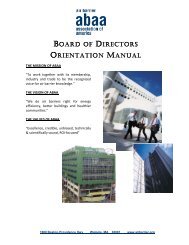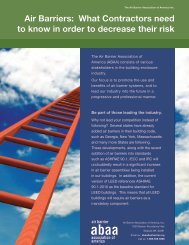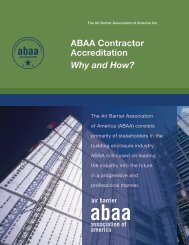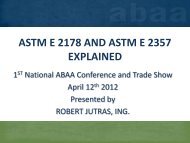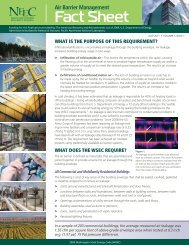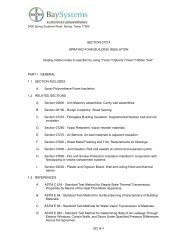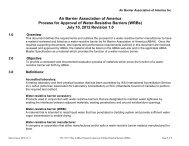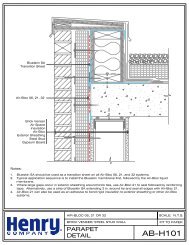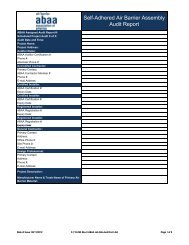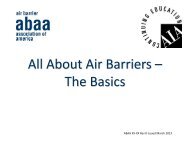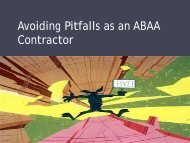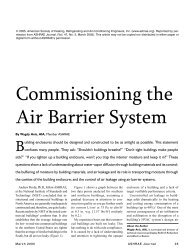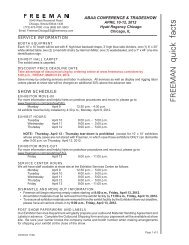Incorporating Air Barriers in Specifications - Renee Doktorczyk
Incorporating Air Barriers in Specifications - Renee Doktorczyk
Incorporating Air Barriers in Specifications - Renee Doktorczyk
You also want an ePaper? Increase the reach of your titles
YUMPU automatically turns print PDFs into web optimized ePapers that Google loves.
<strong>Renee</strong> <strong>Doktorczyk</strong>, CSI, CCS, AIA, SCIPArchiTech Consult<strong>in</strong>g, Inc.Mount Prospect, IL
<strong>Air</strong> Barrier Association of America (ABAA) is aRegistered Provider with The American Institute ofArchitects Cont<strong>in</strong>u<strong>in</strong>g Education Systems. Credit earned oncompletion of this program will be reported to CES Records for AIAmembers. Certificates of Completion for non-AIA members areavailable on request.This program is registered with the AIA/CES for cont<strong>in</strong>u<strong>in</strong>gprofessional education. As such, it does not <strong>in</strong>clude content that maybe deemed or construed to be an approval or endorsement by the AIAof any material of construction or any method or manner of handl<strong>in</strong>g,us<strong>in</strong>g, distribut<strong>in</strong>g, or deal<strong>in</strong>g <strong>in</strong> any material or product. Questionsrelated to specific materials, methods, and services will be addressedat the conclusion of this presentation.
Learn<strong>in</strong>g Objectives• Learn<strong>in</strong>g what specifications are and are not• Learn<strong>in</strong>g how performance requirements of air barriersystems are specified• Learn<strong>in</strong>g how properties of air barrier systems,<strong>in</strong>clud<strong>in</strong>g vapor permeability, air permance, ultimateelongation, and UV-resistance are specified• Learn<strong>in</strong>g how field quality control <strong>in</strong>spections andtests are specified
<strong>Specifications</strong> - Def<strong>in</strong>ed• The <strong>Specifications</strong> are that portion of the ContractDocuments consist<strong>in</strong>g of the written requirements formaterials, equipment, systems, standards andworkmanship for the Work, and performance ofrelated services. (AIA A201 – General Conditions of the Contract forConstruction)
Importance of <strong>Specifications</strong>• <strong>Specifications</strong> are considered part of the ContractDocuments, along with –• Agreement• Conditions of the Contract• Draw<strong>in</strong>gs• Addenda• Modifications (ASI’s and RFI’s)
<strong>Specifications</strong> – CSI & AIA• CSI – Construction <strong>Specifications</strong> Institute• MasterFormat• SectionFormat• AIA – American Institute of Architects• MasterSpec
MasterFormat• A standard number<strong>in</strong>g system used for organiz<strong>in</strong>gspecifications• Sometimes called the “Dewey Decimal System” ofBuild<strong>in</strong>g Construction• Developed by CSI and CSC (Construction<strong>Specifications</strong> Canada)• Includes numbers and titles, but no content
Insert MasterFormat page here
SectionFormat• Standard method for arrang<strong>in</strong>g text with<strong>in</strong> aspecification section• First developed <strong>in</strong> 1969• Part 1 – General• Part 2 – Products• Part 3 - Execution
Insert SectionFormat page here
MasterSpec• Library of master specification sections published byARCOM• ARCOM uses MasterFormat to develop library sectiontitles and numbers• There is not a MasterSpec section for everyMasterFormat number
Insert page from 072626 here
Other Master Specification Systems• Commercially available• BSD SpecL<strong>in</strong>k• E-Specs• SpecText• In-house master specification systems• Association guide specifications, <strong>in</strong>clud<strong>in</strong>g ABAA• Manufacturer guide specifications
<strong>Specifications</strong> are not -
<strong>Specifications</strong> are not -
<strong>Specifications</strong> are not -
<strong>Specifications</strong> are not -
Common <strong>Air</strong> Barrier Types• Spray polyurethane foam <strong>in</strong>sulation air barriers• Build<strong>in</strong>g wraps - residential• Modified bitum<strong>in</strong>ous sheet air barriers• Fluid-applied membrane air barriers• <strong>Air</strong> barrier coat<strong>in</strong>gs
072000 – Thermal Insulation• Sprayed Polyurethane Foam Insulation <strong>Air</strong> <strong>Barriers</strong>• Typically specified <strong>in</strong> the <strong>in</strong>sulation section• Closed cell spray foam <strong>in</strong>sulation becomes an air barrierat 1-1/2 <strong>in</strong>ches thick.• Installed <strong>in</strong> a monolithic manner• Need protective suits and respirators to <strong>in</strong>stall• NFPA 285
072500 – Weather <strong>Barriers</strong>• Build<strong>in</strong>g Wraps• Commonly used for low-rise residential projects• Do not comply with ABAA requirements for air barrierperformance requirements• Tested to ASTM E 1677 limits of 0.06 cfm/sq.ft. at 0.3-<strong>in</strong>ch wg• One of the biggest problems – <strong>in</strong>stallation
072713 – Modified Bitum<strong>in</strong>ousSheet <strong>Air</strong> <strong>Barriers</strong>• Self-adher<strong>in</strong>g sheet products• No special equipment• Consistent thickness• Low-temperature versions (25 to 40 deg F) available
072726 – Fluid-Applied Membrane<strong>Air</strong> <strong>Barriers</strong>• Two Types - Vapor-Retard<strong>in</strong>g and Vapor-Permeable• Elastomeric, modified-bitum<strong>in</strong>ous or synthetic-polymer• Can be applied by roller or sprayed• Forms a monolithic membrane• UV-resistant products available
072729 – <strong>Air</strong> Barrier Coat<strong>in</strong>gs• Two Types - Vapor-Retard<strong>in</strong>g and Vapor-Permeable• Applied <strong>in</strong> a monolithic coat<strong>in</strong>g• Applied th<strong>in</strong>ner than the fluid-applied membrane airbarrier products• Additional coats may be required depend<strong>in</strong>g onsubstrate
Questions to Ponder -• Vapor-retard<strong>in</strong>g vs. vapor-permeable?• Fluid-applied membrane/coat<strong>in</strong>g air barrier?• Elastomeric, modified bitum<strong>in</strong>ous vs. syntheticpolymer?• UV-resistant or non-UV-resistant?• Roller grade vs. spray grade?• Insulat<strong>in</strong>g foam air barrier coat<strong>in</strong>g?• Open cell vs. closed cell?• NFPA requirements?
Part 1 - General• Summary• Identifies type of air barrier• Pre-Installation Conference• Covers special details, mockups, test<strong>in</strong>g, schedul<strong>in</strong>g• Action Submittals• Product Data• LEED – IEQ 4.2• Shop Draw<strong>in</strong>gs
Part 1 – General (cont’d)• Informational Submittals• Qualification Data – Includes list of ABAA <strong>in</strong>stallers• Product Certificates• Product Test Reports• Quality Assurance• Installer Qualifications – Includes ABAA QualityAssurance Program licens<strong>in</strong>g requirements• Mockups
Part 1 – General (cont’d)• Preconstruction Test<strong>in</strong>g• Necessary?• Expensive• Tests that could be <strong>in</strong>cluded -• Qualitative <strong>Air</strong>-Leakage Test<strong>in</strong>g• Quantitative <strong>Air</strong>-Leakage Test<strong>in</strong>g• Adhesion Test<strong>in</strong>g• Delivery, Storage, and Handl<strong>in</strong>g
Part 1 – General (cont’d)• Field Conditions• Warranties• Material – 3 years• Installer – 2 maximum
Part 2 – Products• Materials, General• Source limitations• VOC content• Performance Requirements• <strong>Air</strong> barrier• Liquid-water dra<strong>in</strong>age plane• <strong>Air</strong>-Barrier Assembly <strong>Air</strong> Leakage• Maximum is 0.04 cfm/sq.ft. of surface area at 1.57 lbf/sq.ft. (75Pa) per ASTM E 283, ASTM E 783 or ASTM E 2357
Part 2 – Products (cont’d)• Fluid-Applied Membrane <strong>Air</strong> Barrier• Vapor-Retard<strong>in</strong>g or Vapor-Permeable• Elastomeric, modified bitum<strong>in</strong>ous or Synthetic Polymer• <strong>Air</strong> Barrier Coat<strong>in</strong>gs• Vapor-Retard<strong>in</strong>g or Vapor Permeable• Synthetic Polymer
Part 2 – Products (cont’d)• Product Specific Performance Requirements• <strong>Air</strong> Permeance – Tester per ASTM E 2178• Maximum 0.004 cfm/sq.ft of surface area at 1.57 lbf/sq.ft.• Vapor Permeance – Tested per ASTM E96• Vapor-Retard<strong>in</strong>g - Maximum 0.1 perm• Vapor-Permeable – M<strong>in</strong>imum 10 perms• Ultimate Elongation – Tested per ASTM D412, Die C• Vapor-Retard<strong>in</strong>g – M<strong>in</strong>imum of 500%• Vapor-Permeable – M<strong>in</strong>imum of 200%
Part 2 – Products (cont’d)• Accessory Materials• Primers• Counterflash<strong>in</strong>g strip• Butyl strip• Modified Bitum<strong>in</strong>ous strip• Jo<strong>in</strong>t Re<strong>in</strong>forc<strong>in</strong>g strip• Substrate-patch<strong>in</strong>g membrane• Adhesive and tape• Sta<strong>in</strong>less-steel sheet
Part 2 – Products (cont’d)• Accessory Materials (cont’d)• Sprayed polyurethane foam sealant• Modified bitum<strong>in</strong>ous transition strip• Adhesive-coated transition strip• Elastomeric flash<strong>in</strong>g sheet• Preformed silicone-sealant extrusion• Jo<strong>in</strong>t sealants• Term<strong>in</strong>ation mastic
Part 3 – Execution• Exam<strong>in</strong>ation• Concrete has cured• CMU has flush jo<strong>in</strong>ts• Surface Preparation• Clean, dust-free, dry substrate• Jo<strong>in</strong>t Treatment• Concrete and Masonry• Gypsum Sheath<strong>in</strong>g
Part 3 – Execution (cont’d)• Transition Strip Installation• Roof membranes• Foundation wall waterproof<strong>in</strong>g• Floor-to-floor transitions• Exterior glaz<strong>in</strong>g and w<strong>in</strong>dow systems• Curta<strong>in</strong> wall systems• Storefront systems• Wall open<strong>in</strong>gs
Part 3 – Execution (cont’d)• <strong>Air</strong> Barrier Installation• Primer• Membrane <strong>Air</strong> <strong>Barriers</strong> – 40 mils dft, m<strong>in</strong>imum.• <strong>Air</strong> Barrier Coat<strong>in</strong>gs - + 20 mils dft
Part 3 – Execution (cont’d)• Field Quality Control• Inspections• Test<strong>in</strong>g• Qualitative <strong>Air</strong>-Leakage Test<strong>in</strong>g – ASTM E 1186• Smoke Pencil with pressurization or depressurization• Chamber pressurization or depressurization with smoketracers• Chamber pressurization or depressurization with detectionliquids
Smoke Tracers <strong>in</strong> Whole Build<strong>in</strong>gPressurization or Depressurization
Chamber with Detection Liquids
InfraredScann<strong>in</strong>g
Part 3 – Execution (cont’d)• Quantitative Test<strong>in</strong>g – Per ASTM E 783• Adhesion Test<strong>in</strong>g – Per ASTM D 4541• M<strong>in</strong>imum 30 lbf/sq.<strong>in</strong>. per every 600 sq. ft. <strong>in</strong>stalled• Clean<strong>in</strong>g and Protection• Protect from UV light
Quantitative <strong>Air</strong>-Leakage Test<strong>in</strong>g – ASTM E 783
Architectural Test<strong>in</strong>gPhotos contributed by the follow<strong>in</strong>g:
<strong>Renee</strong> <strong>Doktorczyk</strong>, CSI, CCS, AIA, SCIP<strong>Renee</strong>@ArchiTechSpec.com224-345-3450



